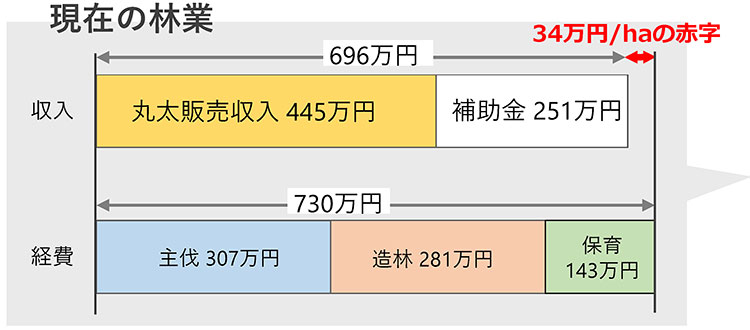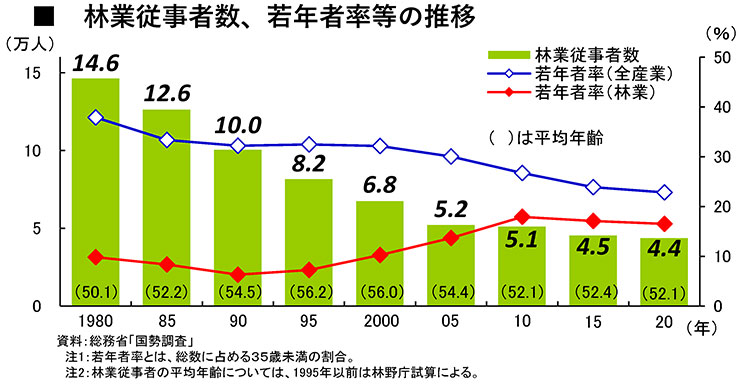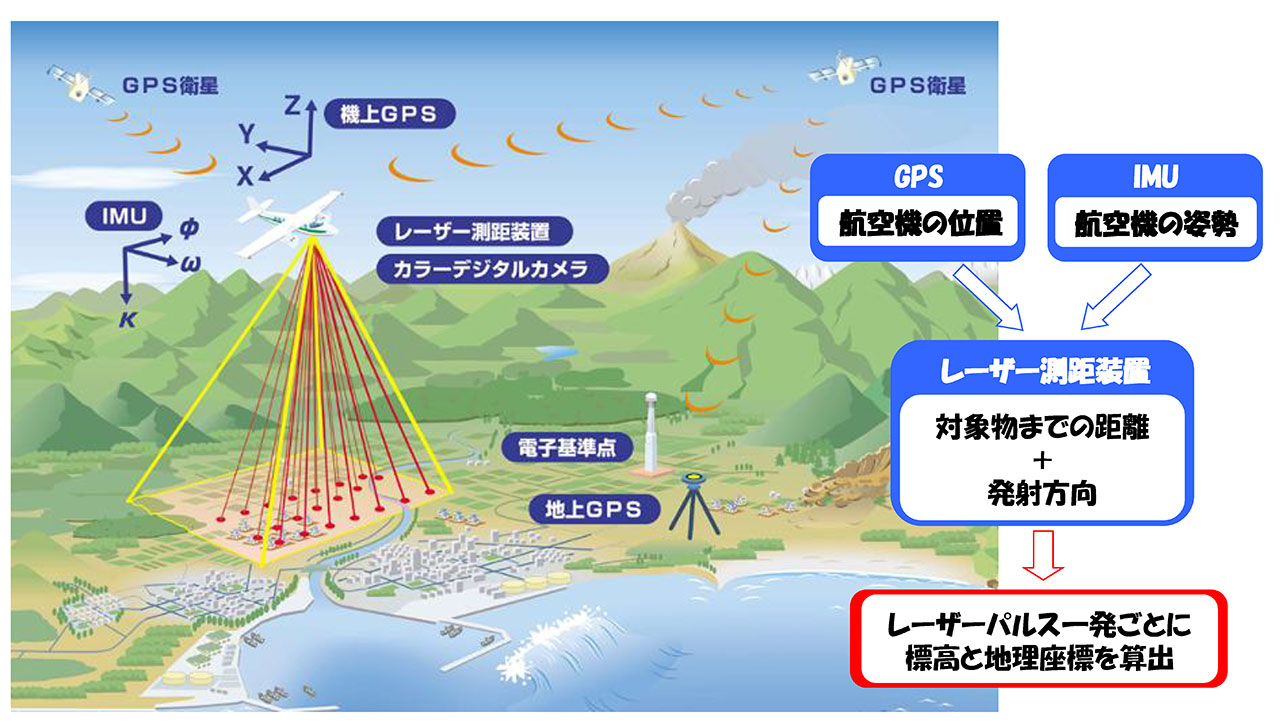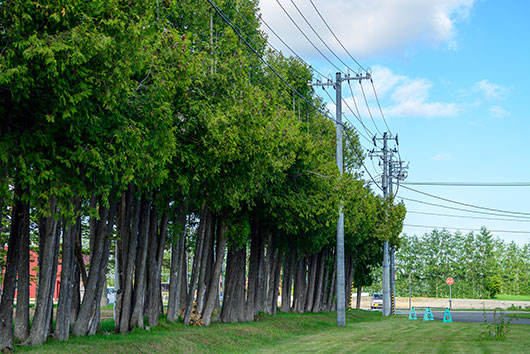Japan is one of the world's leading forested countries. The value of forests is not only being reassessed from the perspective of timber utilization, but also from the perspective of achieving carbon neutrality, disaster prevention, and biodiversity conservation. However, Japan's forestry industry is plagued by low productivity and a serious labor shortage. The promotion of smart forestry is expected to solve these issues. We spoke with three people at PACIFIC CONSULTANTS who are working on this initiative: Hisashi NAKAMURA of the Information Business Dept., Digital Service Div.; Kyosuke SAKURAI of Environmental Symbiosis Dept., Social Innovation Div. and Advanced Technology Center; and Chiyoshi MINAMI of the Project Management Dept., Project Management Div.
INDEX
- What is smart forestry?
- What is needed to revive and develop forestry?
- What can smart forestry do?
- Challenges and efforts in promoting smart forestry
- PACIFIC CONSULTANTS' Initiatives
What is Smart Forestry?
Smart forestry is a type of forestry that aims to reduce labor and increase efficiency in forest resource management and operations through the introduction of advanced technologies such as ICT, robots, and cloud computing, as well as automated machinery. Japan has a forest area of approximately 25 million hectares, accounting for two-thirds of the country's land area, and a vast forest reserve of approximately 5.6 billion cubic meters. In particular, artificial forests have increased dramatically, increasing by approximately six times in the 55 years since 1966, and 60% of them are over 50 years old. To maintain healthy forests, it is necessary to properly harvest, use, and replant them.
However, Japan's forestry industry faces significant challenges. While timber production reached 968 billion yen in 1980, it is expected to plummet to 325.7 billion yen by 2023, a significant drop of one-third. Japan's forestry industry, with most operations located in steep mountains, is inherently difficult to mechanize. Furthermore, privately owned forests, which account for 60% of Japan's forests, are owned by small, micro-forestry owners with land holdings of less than 10 hectares, accounting for 90% of the total. This has hindered progress in modernizing and streamlining management. According to a survey by the Forestry Agency, current forestry management requires 7.3 million yen per hectare for expenses such as felling, afforestation, and forest management, while revenue from log sales is only 4.45 million yen. Even with subsidies of 2.51 million yen, this still results in a deficit of 340,000 yen per hectare.

In addition, the number of people working in forestry was 146,000 in 1980, but this had decreased to 44,000 in 2020, and the area of forest land that is left abandoned with unknown owners has reached approximately 30% of the total forest land area.
Japan is blessed with a warm climate and abundant forests, and is proud of its wood-based culture, including wooden houses. However, if things continue as they are, the forestry industry will continue to decline, leading to forest degradation and the resulting increase in landslides.

What is needed to revive and develop forestry?
To make Japan's forestry industry sustainable, the government has set out three basic policies: the first is "concentration and intensification of forest management," the second is "promotion of road network development," and the third is "promotion of mechanization and digitalization using new technologies," which is the promotion of so-called smart forestry.
In fact, even basic information about where and how much forest resources exist is unclear in Japan's current forestry industry. Each prefecture has a "forest register" that contains comprehensive information on forest resources, such as who owns the forest, when and by whom it was planted, the tree species, timber volume and age, and growth conditions. Many of these registers are created using aerial forest surveying, a technology that interprets tree species and growth conditions from aerial photographs of forests. However, this information is not necessarily highly accurate. As a result, most forest registers are accompanied by the disclaimer, "Compiled through indirect surveys using aerial photographs and interviews, without on-site measurements or verification." Furthermore, due to labor and budget shortages, some forests are unable to keep up with the required regular updates. This means that even when municipalities try to create management plans, the underlying information remains unclear.
Furthermore, the forestry work itself remains labor-intensive and primarily manual. All processes, from transporting seedlings to planting, management and cultivation such as weeding and pruning, surveying growth conditions, and felling and transportation, are still done by hand, just like in the old days. As a result, productivity in Japan's forestry industry is extremely low; according to a survey by the Japan Productivity Center, while the finance and insurance industry earns 9,040 yen per hour worked, the manufacturing industry earns 5,525 yen, and the overall industry average is 4,923 yen, the agriculture, forestry and fisheries industry is significantly lower at 1,500 yen, making it the lowest in a comparison of nominal labor productivity by 16 industries. (Source: "Labor Productivity Levels in Major Industries" (Japan Productivity Center))
Moreover, forestry is the industry with the highest number of work-related accidents of all industries. Looking at the annual rate of deaths and injuries per thousand workers (the number of deaths and injuries per thousand workers per year), the average for all industries in 2023 is 2.4, while the forestry rate is 22.8, nearly ten times higher. Given this current situation, in order to realize a new forestry industry, it is essential to reorganize resource information through smart technology and improve labor productivity through mechanization and automation. (Source: "Current Status of Forestry Work-Related Accidents" (Forestry Agency))
What can smart forestry do?
There are various ICT technologies that can make forestry smarter. The areas in which they are being introduced can be divided into three main categories: Resource management and production planning, production management and distribution, and silviculture. Of these, the area of resource management and production planning has seen the most technological development and adoption.
One of these is the use of laser measurement to understand forest resources and topographical information. Laser measurement involves emitting hundreds of thousands of laser pulses per second from an aircraft, drone, or the ground, measuring the reflection time to determine the distance from the target object, and by analyzing the resulting three-dimensional data (point cloud data), it is possible to determine with high precision the number of trees, standing tree density, tree height (per tree), diameter at breast height (per tree), and volume (per tree).

By using this data as a base and overlaying various other data such as forest type maps and aerial photographs to create a forest GIS (Geographic Information System, a system that overlays various data based on geographic location information on a computer and uses it to make advanced decisions), this can be used to clarify boundaries, create operation plans and forest management plans, and design road networks.
In the "production management and distribution" field, possible applications include the use of timber inspection software, the installation of overhead lines for timber collection using drones, supply and demand matching systems, and web-based log bidding systems. However, actual adoption and widespread adoption in these fields has yet to progress. In the third field, "afforestation," there are applications of remote-controlled felling machines, self-driving forwarders (loaded timber collection vehicles), self-propelled/remote-controlled brush-cutting machines, and the use of drones to transport seedlings and materials, and these have already begun to be demonstrated and put into use.
| Resource Management and Production Planning | ・Laser measurement and analysis from aircraft, drones, or the ground ・Aerial photography and analysis using drones ・Proposals for forest management using forest GIS ・Information sharing via forest cloud, etc. |
| Production Management and Distribution | ・Wood inspection software ・Using drones to check overhead lines ・Supply and demand matching system, etc. |
| Afforestation | ・Remotely controlled felling machines, self-driving forwarders (loading logging vehicles) Use of underbrush cutting machines ・Transportation of seedlings and materials using drones, etc. |
Challenges and efforts in promoting smart forestry
There are a variety of elemental technologies related to smart forestry, and some of them have already begun to be used, but a problem has also emerged: The partial introduction of individual technologies has not led to the development of new forestry practices.
For example, some companies want to try out new technologies, so they use drones to take aerial photographs and perform laser measurements to obtain data, or purchase aerial laser information from aerial surveying companies. However, because there is no clear policy on how the data will be used, there are many cases where this valuable data remains unused. Other examples include companies that have introduced supply-demand matching systems but have not used them, and companies that have purchased remote-controlled brushcutters from machinery manufacturers only to use them experimentally once and then leave them lying dormant in warehouses. Individual component technologies have been developed, and testing and implementation have begun, but because they are not positioned within the overall policy or promotion plan for how to build a new forestry industry in the region, they appear to end up being used only as a "trial run."
In order to make a major shift towards the "new forestry" advocated by the government, the first thing that is needed is to thoroughly examine and reorganize data on local forest resources, and I believe this is the first measure that should be undertaken in order to make use of new technologies.
In fact, there is quite a bit of data already available within the agency that could be put to good use. Forest resource-related data is broadly divided into timber-related and forest-related data, and within forests there is survey and statistical information from different perspectives, such as protection forests, development-related and embankment-related data. There is also tax-related data and survey data for subsidy applications. If all the information pooled in various departments within the agency can be linked using, for example, land numbers as a key, data that can be used for forest management will emerge and a policy for organizing which data should be linked will become clear.
PACIFIC CONSULTANTS' Initiatives
PACIFIC CONSULTANTS provides a wide range of support services to municipalities, prefectures, and business operators, including the reconstruction of forest GIS, the introduction of forest clouds that support information sharing and communication among stakeholders, support for the formulation of forest plans, and consideration of how to comply with forest management systems and utilize forest environment gift taxes. Rather than simply recommending a single technology related to smart forestry, we offer a wide range of support options as consultants.
We also believe it is important for us to have a deep understanding of forestry ourselves, and are in charge of forest management at Daihonzan-Eiheiji Temple in Fukui Prefecture. After a Godai cedar tree's trunk broke in strong winds, damaging the bell tower, we undertook an environmental survey of approximately 200 hectares of forest owned by Eiheiji Temple, which revealed that proper management of the forest was a major issue. After creating and approving a forest management plan, we proceeded with forest management activities such as opening forest work roads and thinning over the next five years. While actually carrying out the work, we became keenly aware of the difficulties and challenges of current forestry, such as the delay in road network development and mechanization.
We are also working on forest digital transformation. As part of this, we are considering how digital technology can be used to maximize the multifaceted functions of forests and make people involved in forests happy. To illustrate what digital technology can do, we are working on organizing current forest information and business flows, holding workshops to consider business models that utilize digital technology, and developing tools to visualize the value of forests.
We are also working to promote J-Credits, a system in which the government certifies greenhouse gas emission reductions and absorption amounts achieved through forest management. Not only can the profits from selling J-Credits to companies be used as a source of funds for forest management, but the purchasing companies can also indirectly cooperate in the healthy development of forests, contributing not only to carbon neutrality but also to the maintenance of biodiversity. The use of J-Credits is also effective in connecting downstream companies not directly involved in forest management with upstream forest owners, and we are promoting forest resource surveys using ICT for forests owned by companies considering generating J-Credits.
PACIFIC CONSULTANTS has a variety of specialized departments in-house, including ICT, disaster prevention, biodiversity, carbon neutrality, road maintenance, and even mechanical and electrical engineering, and possesses cutting-edge knowledge in each field. We hope to continue to utilize our comprehensive strength, which is our hallmark, to contribute to the creation of a new forestry industry through smart technology.









